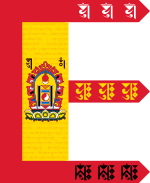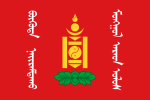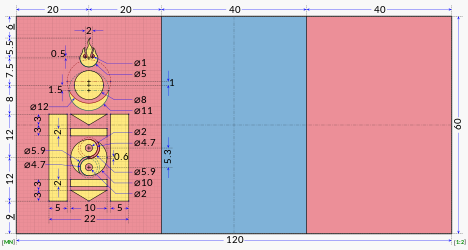Flag of Mongolia
 | |
| Mongolian State Flag | |
| Use | National flag |
|---|---|
| Proportion | 1:2 |
| Adopted | 10 June 1945 (original version with star) 12 January 1992 (star removed) 8 July 2011 (colours standardised) |
| Design | A vertical triband of red (hoist-side and fly-side) and blue with a Soyombo symbol on the hoist-side of the red band with the space above the Soyombo symbol two thirds the height of the space below it. |
| Designed by | Dodiin Choidog |
The national flag of Mongolia (Mongolian: Монгол улсын төрийн далбаа, romanized: Mongol ulsiin töriin dalbaa, pronounced [ˈmɔɴɢɞ̆ɮ ʊɬˈsiŋ tʰɵˈɾiŋ taɮˈpa]) is a vertical triband with a red stripe at each side and a blue stripe in the middle, with the Mongolian Soyombo symbol centering on the leftmost stripe. The blue stripe represents the eternal blue sky, and the red stripes thriving for eternity. The Soyombo symbol is a geometric abstraction that represents fire, sun, moon, earth, water, and a symbol representing two fish as in Mongol mythology fish never sleep thus symbolizing that the spirit of the Mongol people never sleeps.
The current flag was adopted on 12 January 1992,[1] with the current official colour standards being set on 8 July 2011. Until 1992, the flag had a communist star above the Soyombo, during the final 47 years of the Mongolian People's Republic. The flag was originally designed by artist Dodiin Choidog (Додийн Чойдог).[2]
It has become common practice among Mongolians in the Inner Mongolia autonomous region to hang the Mongolian flag, although the Chinese government is allegedly against public displays of Mongolian national or cultural symbols due to concerns of separatism.[3]
Historical flags
| Flag | Date | Description |
|---|---|---|
 |
1911–1920 | Following the 1911 Mongolian declaration of independence during the fall of the Chinese Qing dynasty, the Bogd Khanate of Mongolia adopted a national flag as symbol of this independence.[4][5] The decision to adopt a national flag was also made to follow the international standard at the time in order to promote the image of a modern independent state.[6] A decree established the colours and dimensions of the flag; a yellow oblong rectangle with religious prayer text, in the middle of which was a Soyombo, lotus flower, and the letters "E" and "Bam". From this rectangle flowed red silk tails containing the letters "Om", "Ah", and "Hum".[4][6] Larger flags were intended for government use while smaller versions were intended for ordinary people.[7] Surviving flags can be seen with minor individual differences of the complex design.[6][8][9][10][11] |
 |
1920–1921 | In late 1919 Chinese troops began occupying Mongolia. On 1 January 1920 a ceremony was held which revoked Mongolian autonomy and incorporated it into China, raising the five-striped flag of the Republic of China.[12][13] |
 |
1921–1924 | Following the communist Revolution of 1921 Mongolian independence was restored. The country was formally still a monarchy and its flag remained, which had been carried by many of the revolutionary soldiers.[4] |
  |
1924–1940 | Following the death of the Bogd Khan in 1924, the Mongolian People's Republic was proclaimed. The new republic's first constitution was adopted on 26 November 1924 and described its new flag.[14][15][16] The flag's exact shape and design was not completely standardised and only defined as "the flag is red with the state emblem at the center."[15] It can therefore be seen with some variations, such as without any text or using a rectangular shape without the three tails.[17][18][19][20][21][22] |
 |
1940–1945 |
In November 1939 Mongolian leader Khorloogiin Choibalsan discussed the adoption of a new constitution with the leadership of the Soviet Union while visiting there. On 30 July 1940 the second constitution of the Mongol People's Republic was adopted, and with it, the second flag.[14] After having reviewed a draft of the new state emblem, Joseph Stalin advised that "in order to show that there are many animals, the coat of arms should have a man with a horse in the middle and various animal figures around him".[4] This new emblem, stripped of any remaining religious symbolism, was present on the new flag which was described as "consisting of 1:2 sized red cloth with the state emblem in the center and "Mongol People's Republic" written on either side".[23][15][24] |
 |
1945–1992 | At the Yalta Conference, towards the end of World War II, it was agreed to preserve the status quo of Mongolia's existence. A new flag with national symbolism was considered necessary for the success of Soviet and Mongolian attempts to convince the Chinese to recognize Mongolian independence. Choibalsan brought up the issue of adopting a new flag at the 43rd meeting of the Presidium of the State Conference on 10 July 1945, where the new flag's design was approved.[4][7] Choibalsan chose to restore the Soyombo as a national symbol on the flag and described its adoption as a high celebration of Mongolia's independence.[4][7] The new flag was amended into the constitution in 1949 and was included from the beginning in the constitution adopted in 1960.[16][4][7] The flag was used until the adoption of the democratic constitution and current flag in 1992. |
Other flags of Mongolia
| Flag | Date | Description |
|---|---|---|
 |
1921–1924 | Reconstruction of the flag of the Communist Revolutionary Provisional Government of Mongolia used during the Mongolian Revolution of 1921. There exists no images or surviving examples of this flag, only descriptions. Therefore, dimensions of the flags shape and the exact position of the symbol is unknown.[16] |
 |
1924 | First flag of the Mongolian People's Republic, based on its description in the old constitution. |
 |
1930–1940 | Flag of unclear type used between 1930 and 1940.[25][16] Some sources list it as the national flag between 1930 and 1940, but no clear adoption date or amendment into the constitution exists and evidence shows the 1924-flag being used until 1940. Possibly a civil or naval ensign[citation needed] of the very small Mongolian Navy, which was established in 1930.[26] It is for example listed among flags and maritime ensigns in a Soviet Red Army atlas from 1938.[27] |
 |
"1924–1940" | Erroneous flag of the Mongolian People's Republic, with an unusual blue Soyombo, which appears in several Western sources. This contradicts Mongolian sources, contemporary depictions, and photographic evidence of the real 1924-flag in use at the time. |
 |
Flag of the Mongolian National Olympic Committee. | |
 |
Flag of the Mongolian Armed Forces. | |
 |
Flag of the Mongolian Ground Force | |
 |
Flag of the Mongolian Air Force |
Administrative divisions
-
Flag of Ulaanbaatar
-
Flag of Arkhangai Province
-
Flag of Bayankhongor Province
-
Flag of Bayan-Ölgii Province
-
Flag of Bulgan Province
-
Flag of Darkhan-Uul Province
-
Flag of Dornod Province
-
Flag of Dornogovi Province
-
Flag of DundGobi Province
-
Flag of Govi-Altai Province
-
Flag of Govisümber Province
-
Flag of Khentii Province
-
Flag of Khovd Province
-
Flag of Khövsgöl Province
-
Flag of Orkhon Province
-
Flag of Selenge Province
-
Flag of Sükhbaatar Province
-
Flag of Töv Province
-
Flag of Ömnögovi Province
-
Flag of Uvs Province
-
Flag of Övörkhangai Province
-
Flag of Zavkhan Province
Colours

Official colour standards for the flag were approved in July 2011.[28]
Colours scheme |
Blue | Red | Yellow |
|---|---|---|---|
| RAL | 5015 | 2002 | 1021 |
| Pantone | 300 C | Red 032 C | Medium Yellow C |
| CMYK | 100-60-0-0 | 10-100-90-0 | 0-15-100-0 |
| HEX | #0066B3 | #DA2032 | #FFD400 |
| RGB | 0-102-179 | 218-32-50 | 255-212-0 |
Construction Sheet
See also
- Flag of Inner Mongolia
- List of Mongolian flags
- Emblem of Mongolia
- National anthem of Mongolia
- Soyombo symbol
- Tug (banner)
References
- ^ "FOTW:Flag Dates by country". Archived from the original on 18 March 2023. Retrieved 27 February 2019.
- ^ "Монгол төрийн далбааг зохиосон Додийн Чойдог" [Dodiin Choidog, who designed the Mongolian flag]. Choibalsan.mn (in Mongolian). 19 April 2015. Archived from the original on 23 April 2021. Retrieved 23 April 2021.
- ^ "Southern Mongolia: School Under Investigation for Displaying Flag of Independent Mongolia". 11 January 2019. Archived from the original on 21 December 2022. Retrieved 8 November 2020.
- ^ a b c d e f g "1921 оны хувьсгал ба коминтерн". bolod.mn. Archived from the original on 21 December 2022. Retrieved 1 September 2020.
- ^ "Богд хаант Монгол улсын төрийн далбаа". unuudur.mn/. Archived from the original on 21 December 2022. Retrieved 1 September 2020.
- ^ a b c "БОГД ХААНТ МОНГОЛ УЛСЫН ТӨРИЙН БЭЛГЭДЭЛ". touristinfocenter.mn. Archived from the original on 21 December 2022. Retrieved 1 September 2020.
- ^ a b c d "ӨНӨӨДӨР ТӨРИЙН ДАЛБААНЫ ӨДӨР". www.19001950.mn. Archived from the original on 21 December 2022. Retrieved 1 September 2020.
- ^ "National Museum of Mongolia - 17th-Early 20th century". masterpieces.asemus.museum/. Archived from the original on 19 October 2020. Retrieved 1 September 2020.
- ^ "БОГД ХААНТ МОНГОЛ УЛСЫН ТӨРИЙН ТУГИЙГ ХҮНДЭТГЭХ АРГА ХЭМЖЭЭ 2019 ОНЫ 12 ДУГААР САРЫН 29 НИЙ НЯМ ГАРАГТ БАРУУН ХҮРЭЭ ХИЙДЭД БОЛНО". kharkhorum.mn/. Archived from the original on 21 October 2020. Retrieved 1 September 2020.
- ^ "Flag of Bogd Khaanate Mongolia (1)". markodehaeck.free.fr. Archived from the original on 18 July 2020. Retrieved 1 January 2019.
- ^ "Flag of Bogd Khaanate Mongolia (2)". markodehaeck.free.fr. Archived from the original on 19 July 2020. Retrieved 24 January 2019.
- ^ "Гадаад Монголын өөртөө эзэрхэх засгийг устгасан нь". mongoltoli.mn. Archived from the original on 21 December 2022. Retrieved 1 September 2020.
- ^ Ceremony marking the abolition of Mongolian autonomy
- ^ a b "Монгол Улс ҮНДСЭН ХУУЛИА өөрчиллөө". eguur.mn. 14 November 2019. Archived from the original on 21 December 2022. Retrieved 1 September 2020.
- ^ a b c Inner Asia Volume 9. Global Oriental. 2007.
- ^ a b c d "Mongolia". crwflags.com. Archived from the original on 12 October 1999. Retrieved 29 November 2018.
- ^ Наминчимэд, Баасангийн. "Жинхэнэ эх орончдыг үгүйлэх цаг..." trends.mn. Archived from the original on 3 November 2019. Retrieved 16 May 2019.
- ^ "Mongolian Statehood History Museum (1924 Flag)". markodehaeck.free.fr. Archived from the original on 17 July 2020. Retrieved 29 November 2018.
- ^ https://upload.wikimedia.org/wikipedia/mn/1/14/Mongol-Manjur_border_conference_1937.jpg Archived 25 January 2019 at the Wayback Machine Photo from the Manzhouli conference (1935-1936) which shows the flag of Manchukuo and Mongolia
- ^ Л.Отгонбаатар. "Ялалтын "Дайчин туг"-ийн аялал, уулзалт болов". montsame.mn. Archived from the original on 20 March 2023. Retrieved 1 September 2020. Divisional flag from the Battle of Khalkhin Gol (1939), based on the national flag
- ^ Д.Батбаяр. "Anti-Buddhism poster, 1932". newspress.mn. Archived from the original on 21 October 2020. Retrieved 1 January 2019.
- ^ Л.Отгонбаатар. "Улс тунхагласны баярт зориулан туг далбаагаар үзэсгэлэн гаргажээ". archive.olloo.mn. Archived from the original on 23 October 2020. Retrieved 1 September 2020. Provincial flag from 1923, based on the national flag
- ^ Peaslee, A.J. (1956). Constitutions of Nations. Second Edition. Martinus Nijhoff.
- ^ "Constitution of the Mongol People's Republic (June 30, 1940)". markodehaeck.free.fr. Archived from the original on 17 July 2020. Retrieved 29 November 2018.
- ^ "Mongolian Statehood History Museum (2)". markodehaeck.free.fr. Archived from the original on 17 July 2020. Retrieved 29 November 2018.
- ^ "Mongolia's Strange and Unnecessary (and Really Small) Navy". Dan Lewis. Archived from the original on 19 May 2019. Retrieved 8 March 2017.
- ^ ru:Файл:Флаги.jpg[circular reference]
- ^ "Төрийн далбаа стандарттай болов". Ерөнхийлөгчийн тамгын газар 100-60-0-0 10-100-90-0 0-15-100-0. 8 July 2011. Archived from the original on 16 April 2012. Retrieved 13 March 2012.
























